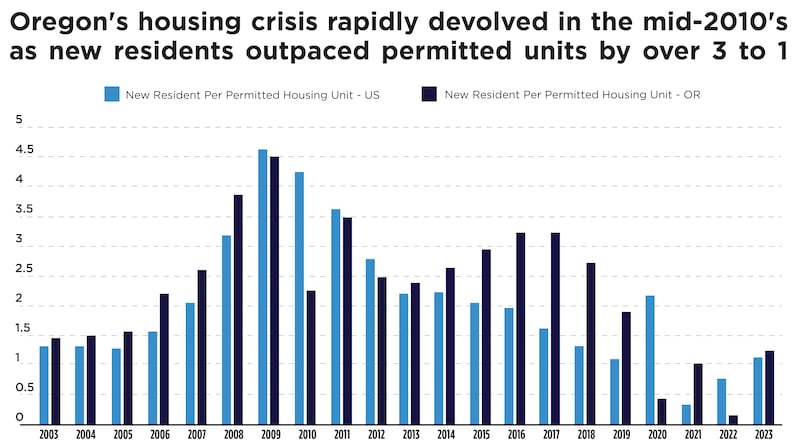Oregon has, by its own numbers, the third-highest rate of homelessness per capita in the county (trailing only New York and Vermont). Many factors contribute, but two are its high rates of substance abuse and mental illness.
A new report released last week by the Oregon Department of Housing & Community Services graphically reveals another: the state’s persistent failure to produce enough housing to keep up with population growth.
The graph below shows that Oregon’s population coming out of the Great Recession grew dramatically faster than the number of new housing units. That drove up rents and home prices, and left many Oregonians with no place to live.

“Between 2015 and 2019, Oregon’s population grew by three residents for every new housing unit,” the report says, “significantly worsening the housing shortage and doubling the national average growth rate.”
Upon her election in 2022, Gov. Tina Kotek made closing the state’s housing deficit one of her top three priorities. Kotek set a goal of producing 36,000 new units of housing annually. Despite record public investments and new laws to relax zoning, streamline permitting, and offer incentives to build, Oregon is on pace to grant permits for about 12,000 new units this year.
At a Dec. 2 press conference, Kotek unveiled her proposed budget for 2025-27. It earmarks $1.4 billion for various housing programs, including $880 million to bond for affordable housing and $100 million for water, sewer and transportation infrastructure. That follows just over $1 billion in her current budget.
Kotek sidestepped questions about why the state has fallen so far short of her 36,000-unit annual goal, pointing instead to successes at getting people housed.
“If we continue at this pace,” the governor said, “the equivalent of nearly 1 in 3 Oregonians experiencing unsheltered homelessness on my first day in office will be rehoused by the end of my first term.”
As for the amount of housing the state is producing, she was succinct: “We are really short.”
The new state report found small rays of sunshine (although the second is a mixed blessing because it stems from a lack of affordability): “Oregon has two favorable conditions for addressing the housing crisis: 1) a strong residential construction industry and 2) slower population growth.”

